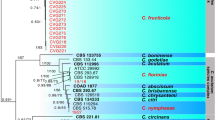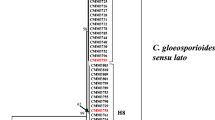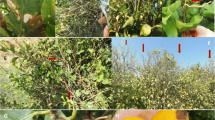Abstract
There have been considerable advances in the understanding of species concepts in the genus Colletotrichum. This has lead to the need to carry out fresh surveys of Colletotrichum species associated with important hosts. Colletotrichum species are associated with Citrus plants as saprobes, important pre-harvest and post-harvest pathogens, as well as endophytes. In this study, a total of 312 Colletotrichum strains were isolated from leaves, shoots and fruits of cultivated Citrus and Fortunella species with or without disease symptoms across the main citrus production areas in China. The morphology of all strains were studied and multilocus (ACT, TUB2, CAL, GAPDH, GS, ITS) phylogeny established. Strains were from four important species complexes of Colletotrichum, namely C. gloeosporioides species complex, C. boninense species complex, C. acutatum species complex and a final group including C. truncatum, which was rare on Citrus species. The species belonging to the C. gloeosporioides species complex comprised C. gloeosporioides and C. fructicola, the C. boninense complex comprised C. karstii and a new species C. citricola and the C. acutatum complex included a new species, C. citri. The ability of strains to cause anthracnose on citrus fruits was tested by inoculation and strains of Colletotrichum gloeosporioides, C. fructicola and C. truncatum were pathogenic.








Similar content being viewed by others
References
Cai L, Hyde KD, Taylor PWJ, Weir B, Waller J, Abang MM, Zhang JZ, Yang YL, Phoulivong S, Liu ZY (2009) A polyphasic approach for studying Colletotrichum. Fungal Diversity 39:183–204
Cannon PF, Buddie AG, Bridge PD (2008) The typification of Colletotrichum gloeosporioides. Mycotaxon 104:189–204
Cannon PF, Damm U, Johnston PR, Weir BS (2012) Colletotrichum-current status and future directions. Stud Mycol 73:181–213
Carbone I, Kohn LM (1999) A method for designing primer sets for speciation studies in filamentous ascomycetes. Mycologia 91:553–556
Chinese Research Institute of Pomology and Citrus (1994) The records of Chinese fruit trees’ diseases and pests (second edition) (in Chinese). China agriculture press
Chomnunti P, Schoch CL, Aguirre-Hudson B, Ko-Ko TW, Hongsanan S, Jones EBG, Kodsueb R, Phookamsak R, Chukeatirote E, Bahkali AH (2011) Capnodiaceae. Fungal Diversity 1–32
Crouch JA, Beirn LA, Cortese LM, Bonos SA, Clarke BB (2009a) Anthracnose disease of switchgrass caused by the novel fungal species Colletotrichum navitas. Mycol Res 113(12):1411–1421
Crouch JA, Clarke BB, Hillman BI (2006) Unraveling evolutionary relationships among the divergent lineages of Colletotrichum causing anthracnose disease in turfgrass and corn. Phytopathology 96(1):46–60
Crouch JA, Clarke BB, White JF Jr, Hillman BI (2009b) Systematic analysis of the falcate-spored graminicolous Colletotrichum and a description of six new species from warm-season grasses. Mycologia 101(5):717–732
Crouch JA, Tomaso-Peterson M (2012) Anthracnose disease of centipede grass turf caused by Colletotrichum eremochloae, a new fungal species closely related to Colletotrichum sublineola. Mycologia 104(5):1085–1096
Damm U, Cannon PF, Woudenberg JHC, Crous PW (2012a) The Colletotrichum acutatum species complex. Stud Mycol 73:37–113
Damm U, Cannon PF, Woudenberg JHC, Johnston PR, Weir BS, Tan YP, Shivas RG, Crous PW (2012b) The Colletotrichum boninense species complex. Stud Mycol 73:1–36
Damm U, Woudenberg J, Cannon P, Crous P (2009) Colletotrichum species with curved conidia from herbaceous hosts. Fungal Diversity 39:45–87
Du M, Schardl CL, Nuckles EM, Vaillancourt LJ (2005) Using mating-type gene sequences for improved phylogenetic resolution of Collectotrichum species complexes. Mycologia 97(3):641–658
Farr DF, Aime MC, Rossman AY, Palm ME (2006) Species of Colletotrichum on Agavaceae. Mycological Research 110(12):1395–1408
Glass NL, Donaldson GC (1995) Development of primer sets designed for use with the PCR to amplify conserved genes from filamentous ascomycetes. Applied and Environmental Microbiology 61(4):1323–1330
Hyde KD, Cai L, Cannon PF, Crouch JA, Crous PW, Damm U, Goodwin PH, Chen H, Johnston PR, Jones EBG (2009a) Colletotrichum-names in current use. Fungal Diversity 39:147
Hyde KD, Cai L, McKenzie EHC, Yang YL, Zhang JZ, Prihastuti H (2009b) Colletotrichum: a catalogue of confusion. Fungal Diversity 39:1–17
Inc. SI (2002–2004) SAS 9.1.3 Help and documentation. Cary, NC: SAS Institute Inc
Johnson DA, Carris LM, Rogers JD (1997) Morphological and molecular characterization of Colletotrichum nymphaeae and C. nupharicola sp. nov. on water-lilies (Nymphaea and Nuphar). Mycol Res 101(6):641–649
Johnston PR, Jones D (1997) Relationships among Colletotrichum isolates from fruit-rots assessed using rDNA sequences. Mycologia :420–430
Ko Ko TW, McKenzie EHC, Bahkali AH, To-anun C, Chukeatirote E, Promputtha I, Abd-Elsalam KA, Soytong K, Wulandari NF, Sanoamuang N (2011a) The need for re-inventory of Thai phytopathogens. Chiang Mai Journal of Science 38:625–638
Ko Ko TW, Stephenson SL, Bahkali AH, Hyde KD (2011b) From morphology to molecular biology: can we use sequence data to identify fungal endophytes? Fungal Diversity 50(1):113–120
Larkin MA, Blackshields G, Brown NP, Chenna R, McGettigan PA, McWilliam H, Valentin F, Wallace IM, Wilm A, Lopez R (2007) Clustal W and Clustal X version 2.0. Bioinformatics 23(21):2947–2948
Lima WG, Spósito MB, Amorim L, Gonçalves FP, de Filho PAM (2011) Colletotrichum gloeosporioides, a new causal agent of citrus post-bloom fruit drop. Eur J Plant Pathol 131(1):157–165
Liu F, Hyde KD, Cai L (2011) Neotypification of Colletotrichum coccodes, the causal agent of potato black dot disease and tomato anthracnose. Mycology 2(4):248–254
MacKenzie SJ, Peres NA, Barquero MP, Arauz LF, Timmer LW (2009) Host range and genetic relatedness of Colletotrichum acutatum isolates from fruit crops and leatherleaf fern in Florida. Phytopathology 99(5):620–631
Marcelino J, Giordano R, Gouli S, Gouli V, Parker BL, Skinner M, TeBeest D, Cesnik R (2008) Colletotrichum acutatum var. fioriniae (teleomorph: Glomerella acutata var. fioriniae var. nov.) infection of a scale insect. Mycologia 100(3):353–374
McGovern RJ, Seijo TE, Hendricks K, Roberts PD (2012) New report of Colletotrichum gloeosporioides causing postbloom fruit drop on citrus in Bermuda. Canadian Journal of Plant Pathology 34(2):187–194
Moriwaki J, Sato T, Tsukiboshi T (2003) Morphological and molecular characterization of Colletotrichum boninense sp. nov. from Japan. Mycoscience 44(1):47–53
Noireung P, Phoulivong S, Liu F, Cai L, Mckenzie EH, Chukeatirote E, Jones E, Bahkali AH, Hyde KD (2012) Novel species of Colletotrichum revealed by morphology and molecular analysis. Cryptogam Mycol 33(3):347–362
O’Donnell K, Nirenberg HI, Aoki T, Cigelnik E (2000) A multigene phylogeny of the Gibberella fujikuroi species complex: Detection of additional phylogenetically distinct species. Mycoscience 41(1):61–78
Pai HS (1970) Life cycle of Colletotrichum heveae inciting spot anthracnose of phyllanthus acidus. Mycopathologia 42(1):65–72
Peng LJ, Sun T, Yang YL, Cai L, Hyde KD, Bahkali AH, Liu ZY (2013) Colletotrichum species on grape in Guizhou and Yunnan provinces, China. Mycoscience 54(1):29–41
Peng LJ, Yang YL, Hyde KD, Bahkali AH, Liu ZY (2012) Colletotrichum species on Citrus leaves in Guizhou and Yunnan provinces, China. Cryptogam Mycol 33(3):267–283
Peres N, MacKenzie S, Peever T, Timmer L (2008) Postbloom fruit drop of citrus and key lime anthracnose are caused by distinct phylogenetic lineages of Colletotrichum acutatum. Phytopathology 98(3):345–352
Phoulivong S (2011) Colletotrichum, naming, control, resistance, biocontrol of weeds and current challenges. Current Research in Environmental Applied Mycology 1(1):53–73
Phoulivong S, Cai L, Chen H, McKenzie EHC, Abdelsalam K, Chukeatirote E, Hyde KD (2010a) Colletotrichum gloeosporioides is not a common pathogen on tropical fruits. Fungal Diversity 44(1):33–43
Phoulivong S, Cai L, Parinn N, Chen H, Abd-Elsalam KA, Chukeatirote E, Hyde KD (2010b) A new species of Colletotrichum from Cordyline fruticosa and Eugenia javanica causing anthracnose disease. Mycotaxon 114(1):247–257
Prihastuti H, Cai L, Chen H, McKenzie EHC, Hyde KD (2009) Characterization of Colletotrichum species associated with coffee berries in northern Thailand. Fungal Diversity 39:89–109
Prihastuti H, Cai L, Crouch JA, Phoulivong S, Moslem MA, McKenzie EHC, Hyde KD (2010) Neotypification of Colletotrichum falcatum, the causative agent of red-rot disease in sugarcane. Sydowia 62:283–293
Rambaut A, Drummond A (2010) FigTree v1. 3.1. Institute of evolutionary biology, University of Edinburgh
Rojas EI, Rehner SA, Samuels GJ, Van Bael SA, Herre EA, Cannon P, Chen R, Pang J, Wang R, Zhang Y (2010) Colletotrichum gloeosporioides sl associated with Theobroma cacao and other plants in Panamá: multilocus phylogenies distinguish host-associated pathogens from asymptomatic endophytes. Mycologia 102(6):1318–1338
Shivas R, Yu Y (2009) A taxonomic re-assessment of Colletotrichum acutatum, introducing C. fioriniae comb. et stat. nov. and C. simmondsii sp. nov. Fungal Diversity 39:111
Stephenson SA, Green JR, Manners JM, Maclean DJ (1997) Cloning and characterisation of glutamine synthetase from Colletotrichum gloeosporioides and demonstration of elevated expression during pathogenesis on Stylosanthes guianensis. Current Genetics 31(5):447–454
Su YY, Noireung P, Liu F, Hyde KD, Moslem MA, Bahkali AH, Abd-Elsalam KA, Cai L (2011) Epitypification of Colletotrichum musae, the causative agent of banana anthracnose. Mycoscience :1–7
Sutton BC (1980) The Coelomycetes, Fungi Imperfecti with acervuli, pycnidia and stromata. Commonwealth Mycological Institute, Kew
Sutton BC (1992) The genus Glomerella and its anamorph Colletotrichum. In: Bailey JA, Jeger MJ (eds) Colletotrichum: Biology, pathology and control. CAB international, Wallingford, pp 1–26
Swofford DL (2003) PAUP*: Phylogenetic analysis using parsimony, version 4.0 b10
Templeton MD, Rikkerink EH, Solon SL, Crowhurst RN (1992) Cloning and molecular characterization of the glyceraldehyde-3-phosphate dehydrogenase-encoding gene and cDNA from the plant pathogenic fungus Glomerella cingulata. Gene 122(1):225–230
Timmer LW, Agostini JP, Zitko S, Zulfiqar M (1994) Postbloom fruit drop, an increasingly prevalent disease of citrus in the Americas. Plant Dis 78(4):329–334
Timmer LW, Garnsey SM, Graham JH (2000) Compendium of Citrus Diseases(secong edition). The American Phytopathological Society 28–29:44–45
Van der Aa HA (1978) A leaf spot disease of Nymphaea alba in the Netherlands. Eur J Plant Pathol 84(3):109–115
Wang XH, Chen GQ, Huang F, Zhang JZ, Hyde KD, Li HY (2012) Phyllosticta species associated with citrus diseases in China. Fungal Diversity 52(1):209–224
Weir BS, Johnston PR, Damm U (2012) The Colletotrichum gloeosporioides species complex. Stud Mycol 73:115–180
White TJ, Bruns T, Lee S, Taylor J (1990) Amplification and direct sequencing of fungal ribosomal RNA genes for phylogenetics. PCR protocols A guide to methods and applications 315–322
Wikee S, Cai L, Pairin N, McKenzie EHC, Su YY, Chukeatirote E, Thi HN, Bahkali AH, Moslem MA, Abdelsalam K, Hyde KD (2011) Colletotrichum species from Jasmine (Jasminum sambac). Fungal Diversity 46(1):171–182
Yang YL, Cai L, Yu ZN, Liu ZY, Hyde K (2011) Colletotrichum species on Orchidaceae in southwest China. Cryptogam Mycol 32(3):229–253
Yang YL, Liu ZY, Cai L, Hyde KD, Yu ZN, McKenzie EHC (2009) Colletotrichum anthracnose of Amaryllidaceae. Fungal Diversity 39:123–146
Acknowledgment
This work was supported by the China Agriculture Research System (CARS-27). L. Cai acknowledges grants KSCX2-YW-Z-1026 ⁄ NSFC31070020. Fang Liu is thanked for technical advices in the phylogenetic analyses. K.D. Hyde thanks the National Research Council of Thailand, Colletotrichum grant number 54201020003 for financial support.
Author information
Authors and Affiliations
Corresponding author
Electronic supplementary material
Below is the link to the electronic supplementary material.
ESM 1
(PDF 67.3 kb)
Rights and permissions
About this article
Cite this article
Huang, F., Chen, G.Q., Hou, X. et al. Colletotrichum species associated with cultivated citrus in China. Fungal Diversity 61, 61–74 (2013). https://doi.org/10.1007/s13225-013-0232-y
Received:
Accepted:
Published:
Issue Date:
DOI: https://doi.org/10.1007/s13225-013-0232-y




